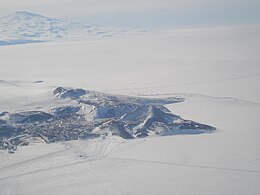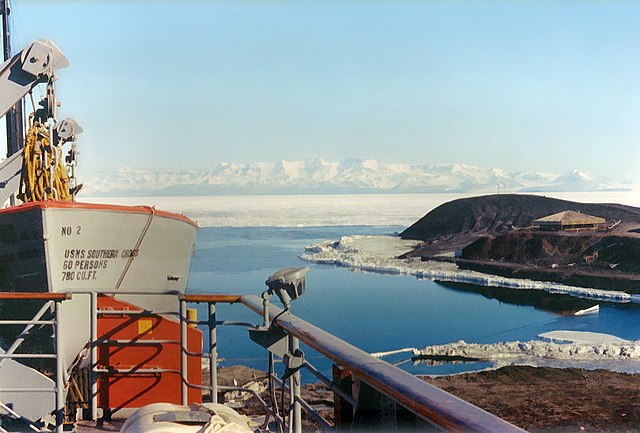Hut Point Peninsula
Landform on Ross Island, Antarctica From Wikipedia, the free encyclopedia
Hut Point Peninsula (77°47′S 166°51′E) is a long, narrow peninsula from 2 to 3 nautical miles (3.7 to 5.6 km; 2.3 to 3.5 mi) wide and 15 nautical miles (28 km; 17 mi) long, projecting south-west from the slopes of Mount Erebus on Ross Island, Antarctica.[1] McMurdo Station (US) and Scott Base (NZ) are Antarctic research stations located on the Hut Point Peninsula.
 Aerial view of the tip of Hut Point Peninsula with McMurdo Station on the near side and Scott Base on the far side | |
| Geography | |
|---|---|
| Location | Antarctica |
| Coordinates | 77°47′S 166°51′E |
| Administration | |
Antarctica | |
| Administered under the Antarctic Treaty System | |
It is also home to historical sites including the Discovery Hut from Robert Falcon Scott's 1901 expedition, and memorials of various types. Hut Point Peninsula is the most inhabited place on Antarctica since the 1950s and is continuously occupied.
History
The British National Antarctic Expedition (1901–04) under Robert Falcon Scott built its Discovery Hut on Hut Point, at the southern headland of the peninsula. Members of the British Antarctic Expedition, 1910–13 (BAE), under Scott, wintering on Cape Evans and often using the hut during their journeys, came to refer to the whole peninsula as the Hut Point Peninsula.[1]
Historic sites and monuments


Several features on Hut Point, including the cross memorial for George Vince and the store hut for the Scott expeditions, are protected under the Antarctic Treaty.[2] Both the cross (HSM 19) and the hut (HSM 18) have been designated Historic Sites or Monuments, following proposals by New Zealand and the United Kingdom to the Antarctic Treaty Consultative Meeting.[3] The point is protected as Antarctic Specially Protected Area No.158 largely because of its historic significance as one of the principal sites of early human activity in Antarctica.[4]
Features
Hut Point Peninsula consists of a series of basaltic scoria cones, craters and domes that were formed in the last 1.34 million years.[5] Other features around the Hut Point Peninsula include Sultans Head Rock, Descent Cliff, Hutton Cliffs, Turtle Rock, Knob Point, Danger Slopes, Arrival Heights, Crater Hill, Hut Point, Cape Armitage, Observation Hill, The Gap and Pram Point.[6]
Craters
First Crater
77°50′S 166°39′E. A crater on Arrival Heights, located 0.75 nautical miles (1.39 km; 0.86 mi) north of Hut Point. Named by Debenham in 1912 on his local survey of Hut Point Peninsula during the British Antarctic Expedition, 1910-13.[7]
Second Crater
77°49′S 166°40′E. A crater on Arrival Heights, situated 0.6 nautical miles (1.1 km; 0.69 mi) northeast of First Crater. Named by F. Debenham in 1912 on his local survey of Hut Point Peninsula during the British Antarctic Expedition, 1910-13.[8]
Sheppard Crater
77.805347°S 166.841572°E. A distinctive breached crater rising to 200 metres (660 ft) high about 0.8 nautical miles (1.5 km; 0.92 mi) east of Castle Rock. Named in 2000 by New Zealand Geographic Board (NZGB) after Deirdre Jeanette Sheppard, DSIR Antarctic Division/NZAP/Antarctica NZ librarian, 1980-96, who worked one season at Vanda Station.[9]
Half Moon Crater
77.807744°S 166.747093°E. A crater 0.5 nautical miles (0.93 km; 0.58 mi) southwest of Castle Rock. Descriptively named for its shape by Frank Debenham of British Antarctic Expedition (British Antarctic Expedition), 1910-13, who made a plane table survey of the peninsula in 1912.[10]
Twin Crater
77.840604°S 166.686128°E. A crater with twin nested cones that rises behind McMurdo Station and 0.5 nautical miles (0.93 km; 0.58 mi) west of Crater Hill. This crater was named Middle Crater by Frank Debenham of the British Antarctic Expedition (British Antarctic Expedition), 1910-13, apparently for its location in relation to First Crater and Crater Hill, but the name has fallen into disuse. Twin Crater, alluding to the nested cones in the crater, was applied as early as 1971 and the name has become established because of consistent use in current maps and reports.[11]
Northern features

Features in the north of the peninsula, from north to south, include
Centipede Nunatak
77.747205°S 166.892322°E. A narrow nunatak that is 0.3 nautical miles (0.56 km; 0.35 mi) long, located 0.8 nautical miles (1.5 km; 0.92 mi) north-northwest of Ford Rock in central Hut Point Peninsula. The name is allusive; snow that cuts across parts of the nunatak gives it a segmented appearance resembling that of a centipede. Named by the Advisory Committee on Antarctic Names (US-ACAN), 2000.[12]
Rodgers Point
77.767734°S 166.783895°E. A point 2.5 nautical miles (4.6 km; 2.9 mi) northeast of Knob Point on the west side of Hut Point Peninsula. Named by New Zealand Geographic Board (NZGB) (2000) after Thelma Rodgers, scientific officer, who was the first woman to winter-over at Scott Base, 1979.[13]
Ford Rock
77°46′S 166°53′E. A prominent rock 1 nautical mile (1.9 km; 1.2 mi) northeast of Cone Hill. Cone Hill and this rock were designated "Cone Hill I" and "Cone Hill II," respectively, by the British Antarctic Expedition under Scott, 1910-13. Cone Hill has been approved for Scott's "Cone Hill I," but a new name suggested by A.J. Heine has been substituted for this prominent rock. M.R.J. Ford, New Zealand surveyor, established a survey beacon network for the McMurdo Ice Shelf Project, 1962-63. A survey beacon was established earlier on this rock by a United States Hydrographic Office survey team, 1955-56.[14]
Cone Hill
77°47′S 166°51′E. A hill 2 nautical miles (3.7 km; 2.3 mi) northeast of Castle Rock. The descriptive name "Cone Hill I" was used by the British Antarctic Expedition under Robert Falcon Scott, 1910-13, but the form Cone Hill has come into general use.[15]
Ackley Point
77.789466°S 166.920391°E. An ice-covered point 1 nautical mile (1.9 km; 1.2 mi) southeast of Cone Hill on the east side of Hut Point Peninsula. Named by the Advisory Committee on Antarctic Names (US-ACAN) in 2000 after Stephen F. Ackley, Snow and Ice Division, U.S. Army Cold Regions Research and Engineering Laboratory (CRREL), Hanover, New Hampshire, a U.S. Antarctic Project (USAP) sea ice specialist who worked in McMurdo Sod and diverse parts of the Southern Ocean for more than 25 years, dating from the 1976-77 austral season.[16]
Central features
Features in the center of the peninsula, from north to south, include
Knob Point
77°48′S 166°40′E. A rounded coastal point on the west side of Hut Point Peninsula. The feature lies 1.5 nautical miles (2.8 km; 1.7 mi) west of Castle Rock. The name was adopted by US-ACAN on the recommendation of Gerald L. Kooyman, USARP biologist who studied physiological characteristics related to diving in the Weddell seal in this vicinity, 1963-64 and 1964-65. Kooyman reported that this descriptive name was already in use by other field workers in the area.[17]
Castle Rock

77°48′S 166°46′E. Bold rock crag, 415 metres (1,362 ft) high, standing 3 nautical miles (5.6 km; 3.5 mi) northeast of Hut Point on the central ridge of Hut Point Peninsula. Discovered by the British National Antarctic Expedition (BrNAE) (1901-04) under Scott, who so named it because of its shape.[18]
Boulder Cones
77.807266°S 166.710021°E. A descriptive name for cones 0.9 nautical miles (1.7 km; 1.0 mi) southwest of Castle Rock. Named by Frank Debenham of the British Antarctic Expedition, 1910–13 (BrAE), who made a plane table survey of the peninsula in 1912.[19]
Arrival Heights

77°49′S 166°39′E. Clifflike heights which extend in a NE--southwest direction along the west side of Hut Point Peninsula, just north of Hut Point. Discovered and named by the BrNAE, 1901-04, under Scott. The name suggests the expedition's arrival at its winter headquarters at nearby Hut Point.[20]
Danger Slopes

77°49′S 166°40′E. An ice slope just south of Knob Point. The initial slope is very steep and it terminates west in a sheer drop to Erebus Bay. So named by BrNAE (1901-04) because Seaman Vince of BrNAE lost his life here in a blizzard when he slipped and fell into the sea.[21]
Starr Lake
77°50′S 166°40′E. A small meltwater lake which is a source of water for McMurdo Station. The lake is situated in the area of constant snow cover on Hut Point Peninsula, approximately 0.5 nautical miles (0.93 km; 0.58 mi) north of the station and midway between First Crater and Crater Hill. The name Starr Lake came into general use at McMurdo Station for this feature in the early 1970's. It is named after James W. Starr, steelworker, United States Navy, who was closely associated with the development of the lake as a source of station water.[22]
Crater Hill
77°50′S 166°43′E. A hill, 300 metres (980 ft) high, marked by a volcanic crater at its summit, about 1 nautical mile (1.9 km; 1.2 mi) north of Observation Hill in the south part of Hut Point Peninsula. Discovered and named by the BrNAE under Scott, 1901-04.[23]
Polar Bear Point
77.816287°S 166.851715°E. An ice-covered point 1.2 nautical miles (2.2 km; 1.4 mi) southeast of Castle Rock on the east side of Hut Point Peninsula. A breached crater stands 0.7 nautical miles (1.3 km; 0.81 mi) north-northwest, but no rock is exposed on the point which is well defined and elevated at the juncture with McMurdo Ice Shelf. The name is allusive; when viewed from the west, the appearance of the point is suggestive of the head, neck, and fore part of an Arctic polar bear. Named by the Advisory Committee on Antarctic Names (US-ACAN), 2000.[24]
Southern features
Features in the south of the peninsula, from west to east, include
Black Knob
77.838187°S 166.663478°E. A descriptive name for a rock outcrop 0.2 nautical miles (0.37 km; 0.23 mi) west of Twin Crater/Middle Crater. The name has been used in reports and maps since at least 1971.[25]
Winter Quarters Bay

77°51′S 166°37′E. A small bay immediately east of Hut Point, at the south end of Ross Island. Discovered by the BrNAE, 1901-04, and so named because the expedition ship Discovery was moored in the bay and "frozen-in" during the winter seasons of 1902 and 1903.[26]
Hut Point
77°51′S 166°38′E. A small point lying 1 nautical mile (1.9 km; 1.2 mi) northwest of Cape Armitage, at the south end of Hut Point Peninsula. Discovered and named by the BrNAE (1901-04) under Scott, who established their hut on the point.[1]
Observation Hill

77°51′S 166°40′E. Conical hill, 230 metres (750 ft) high, surmounting Cape Armitage at the south end of Hut Point Peninsula. Discovered by the BrNAE, 1901-04, under Scott, and so named because it forms an excellent lookout station.[27]
Cape Armitage
77°51′S 166°40′E. Cape forming the south end of Hut Point Peninsula and the southernmost point of Ross Island. Discovered by the BrNAE, 1901-04, under Scott, and named by him for Lieutenant (later Captain) Albert B. Armitage, second in command and navigator on the Discovery.[28]
Fortress Rocks
77°51′S 166°41′E. A cluster of low rock summits 0.5 nautical miles (0.93 km; 0.58 mi) north of the summit of Observation Hill on Hut Point Peninsula. A descriptive name given by members of the British Antarctic Expedition, 1910-13, under Scott.[29]
The Gap
77°51′S 166°43′E. A pass between Crater Hill and Observation Hill at the south end of Hut Point Peninsula. Charted and named by the BrNAE, 1901-04, under Scott. BrNAE sledge parties traversed the south end of the peninsula via this low level passage.[30]
Pram Point
77°51′S 166°45′E. Low rounded point on the southeast side of Hut Point Peninsula, about 1.5 nautical miles (2.8 km; 1.7 mi) northeast of Cape Armitage. Discovered by the BrNAE, under Scott, 1901-04, who so named it because it is necessary during the summer months to use a pram in the open water adjacent to the point when traveling between the south end of Hut Point Peninsula and the Ross Ice Shelf.[31]
References
Sources
Wikiwand in your browser!
Seamless Wikipedia browsing. On steroids.
Every time you click a link to Wikipedia, Wiktionary or Wikiquote in your browser's search results, it will show the modern Wikiwand interface.
Wikiwand extension is a five stars, simple, with minimum permission required to keep your browsing private, safe and transparent.

